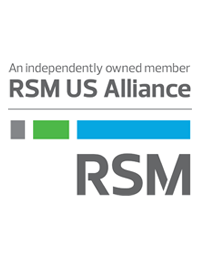Source: RSM US LLP. PBMares is a member of RSM US Alliance.
TAX ALERT |
How do you spell relief? Like the old Rolaids commercial, Congress is coming to aid to the many multiemployer pensions plans suffering from their own form of acid indigestion.
Background
Multiemployer pensions are collectively bargained defined benefit retirement plans, many of which are significantly underfunded.
Section 432 requires an enrolled actuary to certify a multiemployer pension plan’s annual funding status. Potentially, the actuary could classify the plan’s status as (1) endangered, (2) seriously endangered, (3) critical, or (4) critical and declining. In summary:
1. A multiemployer plan is in endangered status if the plan’s actuary determines the plan is (a) less than 80% funded or has an accumulated funding deficiency for a plan year, or (b) the actuary projects the plan to have an accumulated funding deficiency for any of the six succeeding plan years.
2. If both (a) and (b) above apply, the plan is seriously endangered.
3. A multiemployer plan is in critical status if:
a. It is less than 65% funded and has a projected funding deficiency within five years or an inability to pay benefits within seven years.
b. The actuary projects the plan to have a funding deficiency within four years or an inability to pay benefits within five years; or
c. Its benefits for inactive members are greater than for active ones, contributions less than carrying costs, and a projected funding deficiency within five years.
4. A multiemployer plan achieves critical and declining status if, among other criteria, it is within 20 years of projected insolvency.
These funding rules have required many multiemployer plans to reduce promised and accrued benefits to their members and to adopt funding improvements or overall rehabilitation plans with a goal of getting funding and assets in better alignment.
Direct financial assistance
The most notable relief is the direct financial assistance that the Pension Benefit Guaranty Corporation (PBGC) will be able to provide the plans in the most serious financial condition. To be eligible, a plan must be meet one of four conditions:
- Be in critical and declining status,
- Have previously imposed a benefit suspension under the terms of the Multiemployer Pension Reform Act of 2014 (MPRA),
- Be in critical status, have a modified funded percentage of less than 40% on a current liability basis, and have a ratio of active to inactive participants of less than 2 to 3, or
- Be insolvent.
The PBGC is to prioritize plans that are insolvent, that require more than $1 billion of financial assistance or that have suspended benefits under MPRA.
The objective is for the PBGC to provide such plans with a single lump sum payment that would allow it, on a projected basis, to remain solvent through the plan’s 2051 plan year. In other words, Congress is providing 30 years’ worth of funding assistance.
Unlike other PBGC insurance programs that receive their funding from the premiums paid by covered plans, this funding will come to the PBGC directly from the U.S. Treasury.
Plans that benefit from this program will still need to make their annual PBGC premium payments and the flat-rate portion of the premiums increase to $52 (indexed) per participant beginning in 2031.
Other relief
In addition to the direct financial assistance, the Act provides additional multiemployer pension plan relief by permitting any multiemployer plan to do the following:
- Elect the same funding status (described above) as applied in the previous plan year for either the 2020 plan year or the 2021 plan year.
- If the plan was operating under a funding improvement or rehabilitation plan in 2020 or 2021, the plan can chose to extend the improvement or rehabilitation period an additional five years.
- Use actuarial smoothing to amortize the plan’s 2020 and 2021 investment losses for up to 10 years.
- Amortize over 30 years the plan’s 2020 and 2021 experience losses.
Single employer plan funding relief
In 2012, Congress enacted Moving Ahead for Progress in the 21st Century Act (MAP-21). MAP-21 (including subsequent modifications) used an interest rate smoothing concept to reduce the required funding. However, the smoothing provision was to begin phasing out in 2021. The Act provides single-employer plan funding relief by extending the MAP-21 amortization period for funding shortfalls and the pension funding stabilization percentages.
The Setting Every Community Up for Retirement Enhancement Act (SECURE Act) provided community newspaper plans the option to elect to determine the required funding for a plan by using more favorable interest rates and amortization periods for funding shortfalls than what normally applies to a single employer plan. For example, a community newspaper plan can amortize funding shortfalls over a 30-year period and calculate current liabilities using an 8% interest rate. This Act expands the SECURE Act relief to additional community newspapers.
This article was written by Bill O’Malley and originally appeared on 2021-03-12.
2020 RSM US LLP. All rights reserved.
https://rsmus.com/what-we-do/services/tax/compensation-and-benefits/employee-benefits-programs/american-rescue-plan-act-provides-aid-to-pension-plans.html
The information contained herein is general in nature and based on authorities that are subject to change. RSM US LLP guarantees neither the accuracy nor completeness of any information and is not responsible for any errors or omissions, or for results obtained by others as a result of reliance upon such information. RSM US LLP assumes no obligation to inform the reader of any changes in tax laws or other factors that could affect information contained herein. This publication does not, and is not intended to, provide legal, tax or accounting advice, and readers should consult their tax advisors concerning the application of tax laws to their particular situations. This analysis is not tax advice and is not intended or written to be used, and cannot be used, for purposes of avoiding tax penalties that may be imposed on any taxpayer.
RSM US Alliance provides its members with access to resources of RSM US LLP. RSM US Alliance member firms are separate and independent businesses and legal entities that are responsible for their own acts and omissions, and each are separate and independent from RSM US LLP. RSM US LLP is the U.S. member firm of RSM International, a global network of independent audit, tax, and consulting firms. Members of RSM US Alliance have access to RSM International resources through RSM US LLP but are not member firms of RSM International. Visit rsmus.com/aboutus for more information regarding RSM US LLP and RSM International. The RSM(tm) brandmark is used under license by RSM US LLP. RSM US Alliance products and services are proprietary to RSM US LLP.





